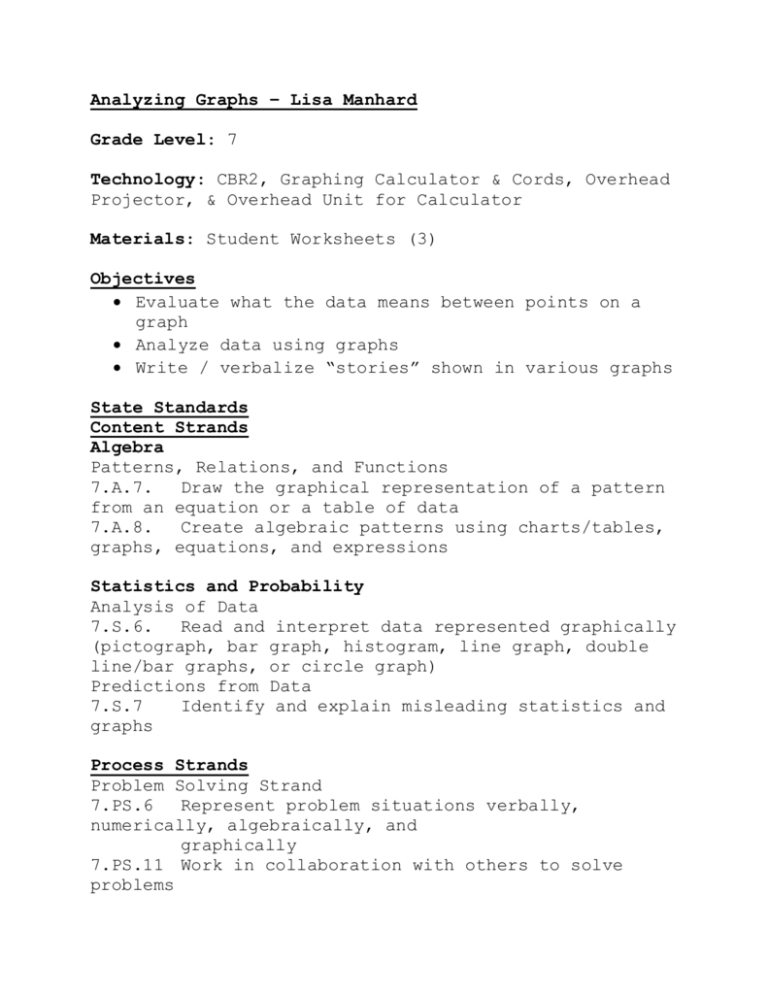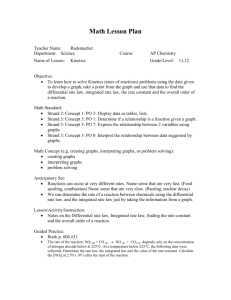
Analyzing Graphs – Lisa Manhard
Grade Level: 7
Technology: CBR2, Graphing Calculator & Cords, Overhead
Projector, & Overhead Unit for Calculator
Materials: Student Worksheets (3)
Objectives
Evaluate what the data means between points on a
graph
Analyze data using graphs
Write / verbalize “stories” shown in various graphs
State Standards
Content Strands
Algebra
Patterns, Relations, and Functions
7.A.7.
Draw the graphical representation of a pattern
from an equation or a table of data
7.A.8.
Create algebraic patterns using charts/tables,
graphs, equations, and expressions
Statistics and Probability
Analysis of Data
7.S.6.
Read and interpret data represented graphically
(pictograph, bar graph, histogram, line graph, double
line/bar graphs, or circle graph)
Predictions from Data
7.S.7
Identify and explain misleading statistics and
graphs
Process Strands
Problem Solving Strand
7.PS.6
Represent problem situations verbally,
numerically, algebraically, and
graphically
7.PS.11 Work in collaboration with others to solve
problems
Reasoning & Proof Strand
7.RP.4
Provide supportive arguments for
conjectures
Communication Strand
7.CM.1
Provide a correct, complete, coherent, and
clear rationale for thought
process used in problem solving
7.CM.6
Analyze mathematical solutions shared by others
7.CM.9
Increase their use of mathematical vocabulary
and language when
communicating with others
Connections Strand
7.CN.3
Connect and apply a variety of strategies to
solve problems
Representation Strand
7.R.1
Use physical objects, drawings, charts,
tables, graphs, symbols,
equations, or objects created using technology
as representations
NCTM Standards
Content Strands
Algebra Strand
Understand patterns, relations, and functions
represent, analyze, and generalize a variety of
patterns with tables, graphs, words, and, when
possible, symbolic rules
Use mathematical models to represent and understand
quantitative relationships
model and solve contextualized problems using various
representations, such as graphs, tables, and
equations.
Process Strands
Problem Solving
monitor and reflect on the process of mathematical
problem solving.
Communication Standard
organize and consolidate their mathematical thinking
through communication;
communicate their mathematical thinking coherently and
clearly to peers, teachers, and others;
analyze and evaluate the mathematical thinking and
strategies of others;
use the language of mathematics to express
mathematical ideas precisely
Connections Standard
use connections among mathematical ideas
understand how mathematical ideas interconnect and
build on one another to recognize and produce a
coherent whole
recognize and apply mathematics in contexts outside
of mathematics.
Resources
Analyzing Graphs Worksheet (Launch)
Connected Mathematics 2: Variables and Patterns © 2006
Author(s): Glenda Lappan, James T. Frey, William M.
Fitzgerald, Susan N. Friel, & Elizabeth Difanis
Phillips
Publisher: Pearson / Prentice Hall
Reflection Questions Worksheet (Summarize)
URL:
http://www.mste.uiuc.edu/presentations/motionStory.htm
Title: Motion Story
Author: None given
Homework Sheet
URL:
http://dev.physicslab.org/Document.aspx?doctype=5&filen
ame=Kinematics_SVAcombinations.xml
Title: Position-Time Graph "Story" Combinations
Author: Catharine H. Colwell
Launch (10 Minutes)
Worksheet: Analyzing Graphs – show on overhead and
complete the three questions as a whole class. Have a
student come up to the overhead to give their answer
and explain why it makes sense.
(From: Connected Mathematics 2: Variables and Patterns
© 2006)
Explore (20 Minutes)
Display a graph on the board using a CBR. Discuss the
graph and analyze it. What variables are we using?
How do we know? Explain that the distance (m) is the
distance away from the motion detector (CBR2). What's
happening?
Have a student volunteer try to "match the graph" as
another student (coach) helps explain what the student
walking should do. If necessary, have another pair of
students try to match the same graph based on how well
/ what the first group accomplished.
Repeat with a new graph.
Summarize (10 Minutes)
Reflection Questions Worksheet:
When "matching the graphs" by walking, how did we know
if the person walking had to walk faster or slower?
When "matching the graphs" by walking, how did we know
if the person walking had to walk toward or away from
the CBR?
Draw a graph for the following story:
A person who walks two blocks at a moderate speed,
waits at an intersection for a short time until the
"walk" light turns "green," then walks the next block
more slowly, and finally runs the final two blocks very
rapidly.
(From:
http://dev.physicslab.org/Document.aspx?doctype=5&filen
ame=Kinematics_SVAcombinations.xml)
Have a student come up to the overhead to draw their
graph. Have them then explain it to the class.
Homework
Worksheet: Graph Stories
(From:
http://www.mste.uiuc.edu/presentations/motionStory.htm)
Analyzing Graphs Worksheet
Investigation 2: Analyzing Graphs
1. Which graph below could match the situation described?
A car traveling at 0 mi/h accelerates to 25 mi/h over the first 5 seconds. It maintains that speed
for the next 5 seconds, and then accelerates to 48 mi/h during the next 5 seconds.
a.
c.
b.
d.
2. Select a graph for the situation. You wait for the express bus for 30 minutes, get on and ride
the bus non-stop for 3 miles, and then walk another mile to your home.
a.
c.
b.
d.
3. Which graph most likely describes the distance a person walks in a 24-hour period? Why?
a. Graph II
b. Graph III
c. Graph IV
d. Graph I
Connected Mathematics 2: Variables and Patterns © 2006
Reflections Questions Worksheet
Name ___________________________________
HR _____________ ID# ________
Math
Date _________________________
1. When "matching the graphs" by walking, how did we know if
the person walking had to walk faster or slower?
_____________________________________________________
_____________________________________________________
_____________________________________________________
_____________________________________________________
2. When "matching the graphs" by walking, how did we know if
the person walking had to walk toward or away from the CBR?
_____________________________________________________
_____________________________________________________
_____________________________________________________
_____________________________________________________
3. Draw a graph for the following story:
A person who walks two blocks at a moderate speed, waits at
an intersection for a short time until the "walk" light turns
"green," then walks the next block more slowly, and finally runs
the final two blocks very rapidly.
QuickTime™ and a
TIFF (Uncompressed) decompressor
are needed to see this picture.
http://www.mste.uiuc.edu/presentations/motionStory.htm
Homework
Name ___________________________________
HR _____________ ID# ________
Math
Date _________________________
Which story goes with which graph? Match the stories with three of the
graphs in below and write a story for the remaining graph.
QuickTime™ and a
TIFF (Uncompressed) decompressor
are needed to see this picture.
(a.) I had just left home when I realized I
had forgotten my
books, so I went back to
pick them up.
(b.) Things went fine until I had a flat tire.
(c.) I started out calmly, but sped up when I
realized I was going to be late.
(d.)
http://dev.physicslab.org/Document.aspx?doctype=5&filename=Kinematics_SVAcomb
inations.xml








